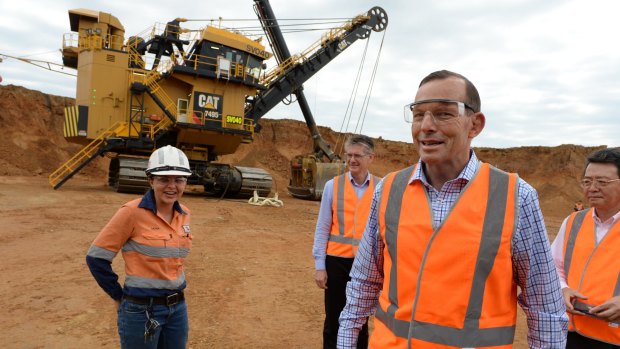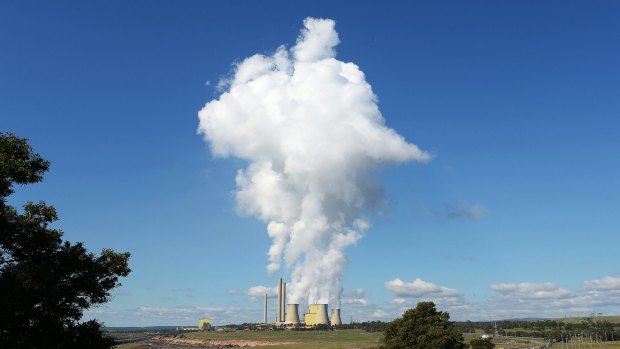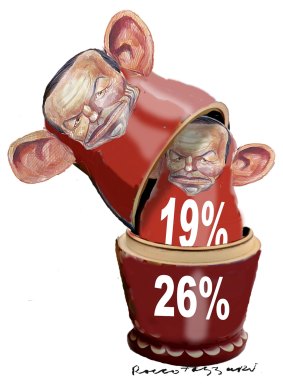By Tom Arup
- Peter Hartcher: There's only one science Tony Abbott trusts - political science
- Emissions reduction target put to Coalition party room
- Politics Live: Stephanie Peatling live from Parliament
Any doubts that the Abbott government regards climate change as largely a political management exercise should be dispelled with the release of Australia's new emissions target for 2030.
The goal announced on Tuesday - a 26 to 28 per cent cut to emissions from 2005 levels - looks like it has been based largely on what the government thinks is the minimum it can get away with in the international community and among the Australian public.
But it falls short on three key measures: the science, the pace of international action and what can technically be achieved.
Let's break them down.

Tony Abbott, pictured at the Caval Ridge coal mine, has said "coal is good for humanity".Credit: AAP
The science
Amid all the talk of percentages, baselines and Paris summits it is worth remembering what this is all about - an environmental crisis.
Humans are producing reckless amounts of pollution in the form of greenhouse gases, which is making the planet a more dangerous place to live.
The more average global temperatures rise above pre-industrial levels, the more dangerous it will get. Once warming hits 2 degrees it will unleash the worst (and probably unmanageable) impacts of climate change on our quality of life, our ability to produce food and to live safely.
It is tricky to determine what is a fair burden for each country in helping to stop global warming before we hit that 2 degree mark. But on most credible attempts, this target falls short of Australia's appropriate contribution.

The Loy Yang A coal plant in Victoria.Credit:
In fact, under a "carbon budget" calculation, the targets are more consistent with global warming of3 to 4 degrees, according to the Climate Institute.
Factoring in the 2degree goal - which countries have agreed to meet through the United Nations - is a large reason why the Climate Change Authority recommended a 40 to 60 per cent cut to emissions by 2030 from 2000 levels for Australia. And it is why the Australia Academy of Science recommended a 30 to 40 per cent cut by 2030 from the same baseline.

Illustration: Rocco Fazzari
International action
Australia was already firmly in the sights of the international community over its perceived climate recalcitrance. China, Brazil and the United States in particular have been asking questions of our ambition and policies.
While there was no expectation Australia had to match the ambition out of Europe (where economic and population growth is flat), the international community would have been expecting more from a country with the highest emissions per person in the developed world.
On absolute emissions this target places Australia behind most comparable countries including the US, UK, Canada, and New Zealand (see table below). It is only slightly ahead of Japan, which is still dealing with the fallout of the Fukushima nuclear disaster.
In particular, falling short of Canada - whose goal of a 30 per cent cut by 2030 on 2005 levels is itself regarded as weak - will win Australia few friends as it is seen as an equivalent economy with large interests in resources.
What could be achieved
The Abbott government is yet to produce its full economic modelling to justify its choice of this target over more ambitious goals.
Other studies by academics and think-tanks have found Australia can drive deeper cuts to emissions without crushing the economy (although we would have to accept a reduction in projected future economic growth).
In one example researchers at the Australian National University and ClimateWorks modelled a potential pathway for Australia to cut its emissions to zero by 2050. To get there Australia would need to cut emissions by 52 per cent by 2030 from 2005 levels.
The study found these goals were achievable with the technology we have at hand today; meanwhile the economy would still grow by 150 per cent out to 2050.
This pathway would require Australia to embrace new ways to cut energy use in buildings, transport and industry. We would need to move largely to renewable energy (and nuclear and carbon capture and storage if we so decided) and ensure that our forests and vegetation cover grew to offset the emissions we could not get rid of.
The Abbott government has its arguments for setting a scaled-back target. In particular it is pointing to Australia's projected population and economic growth.
Allowances for this should be made. But it hardly accounts for why we are doing less than our international counterparts, or what the science is demanding, or what some modelling shows we can practically achieve.
Ultimately this target could further erode Australia's standing in international climate negotiations, curbing our ability to influence their outcome and protect our national interest.
And we are at risk of further entrenching ourselves as a climate laggard.